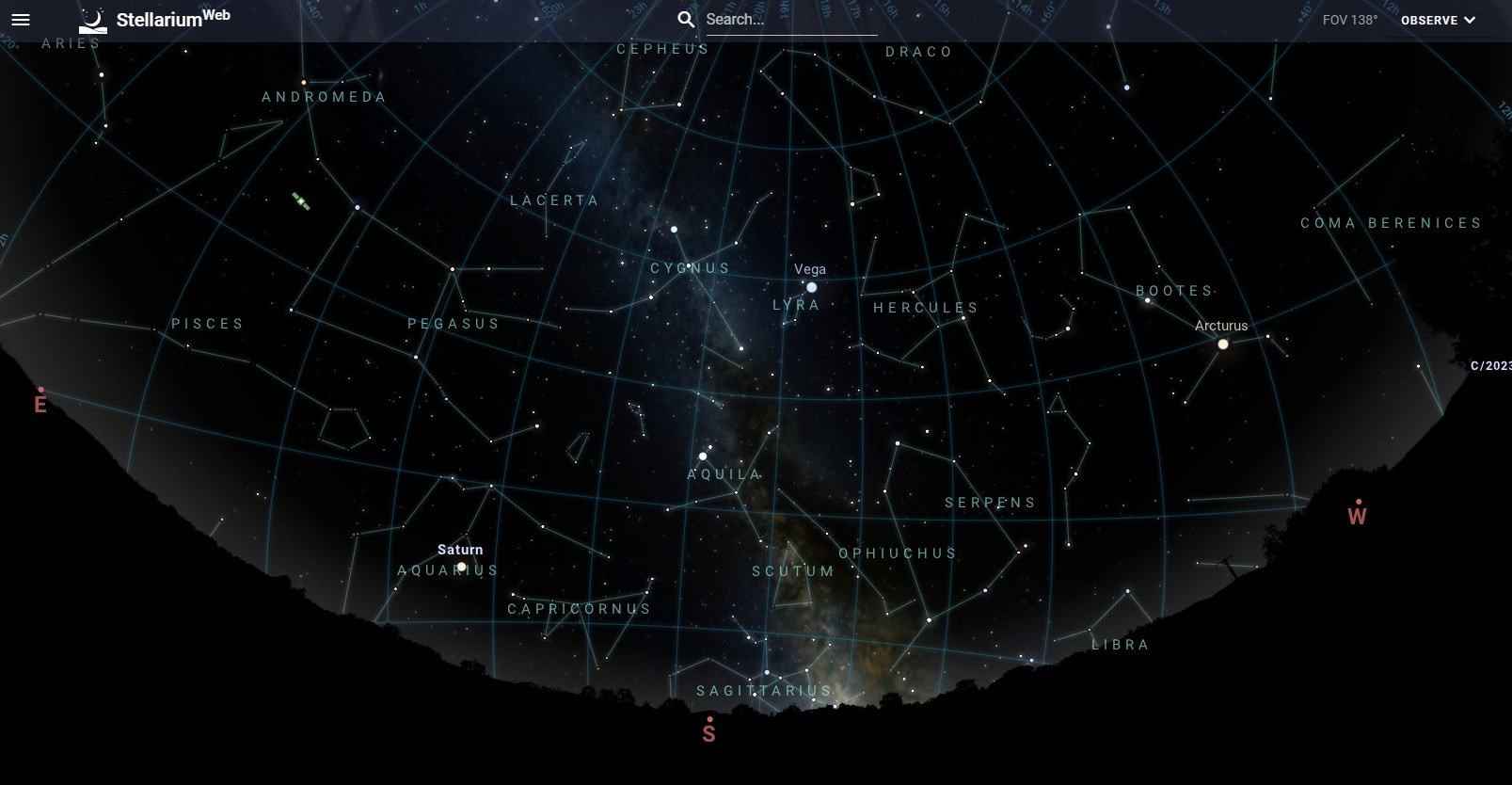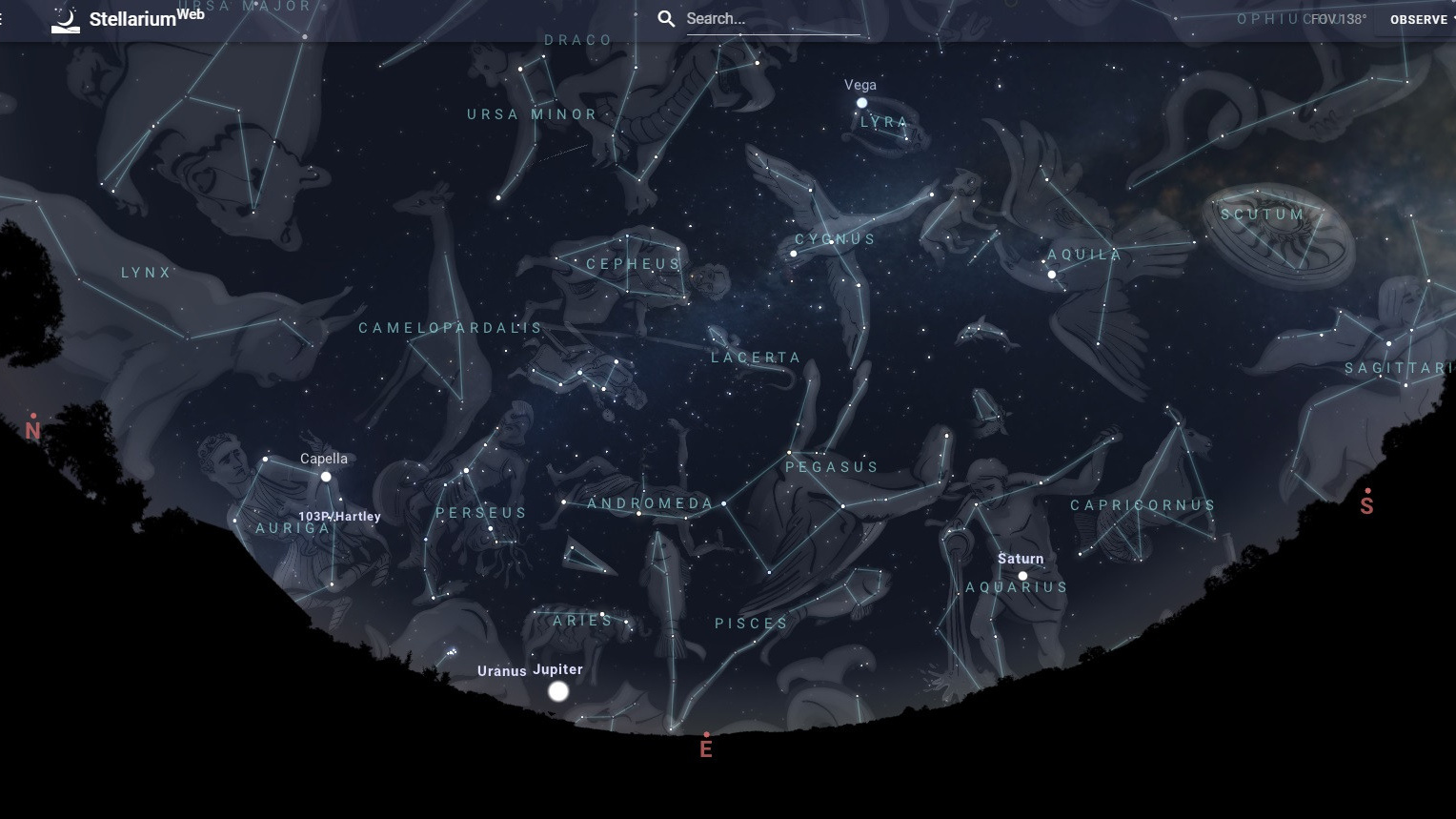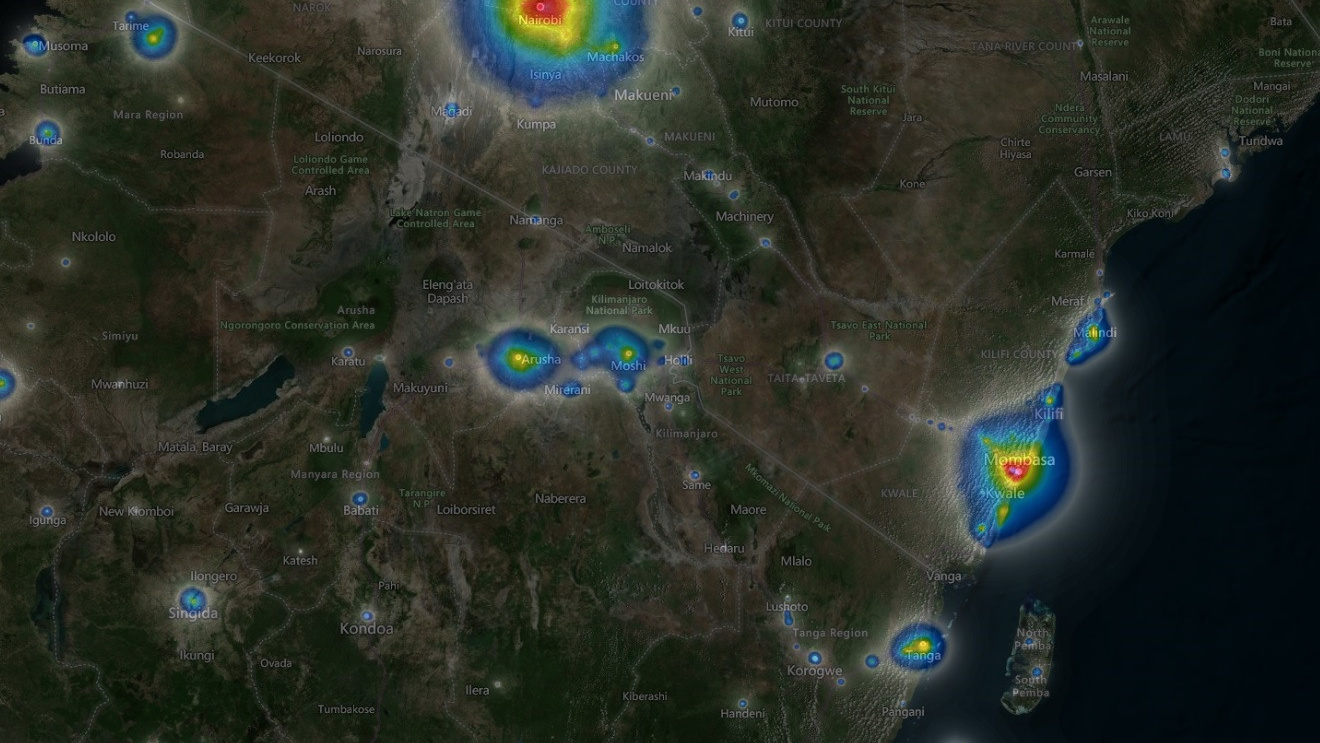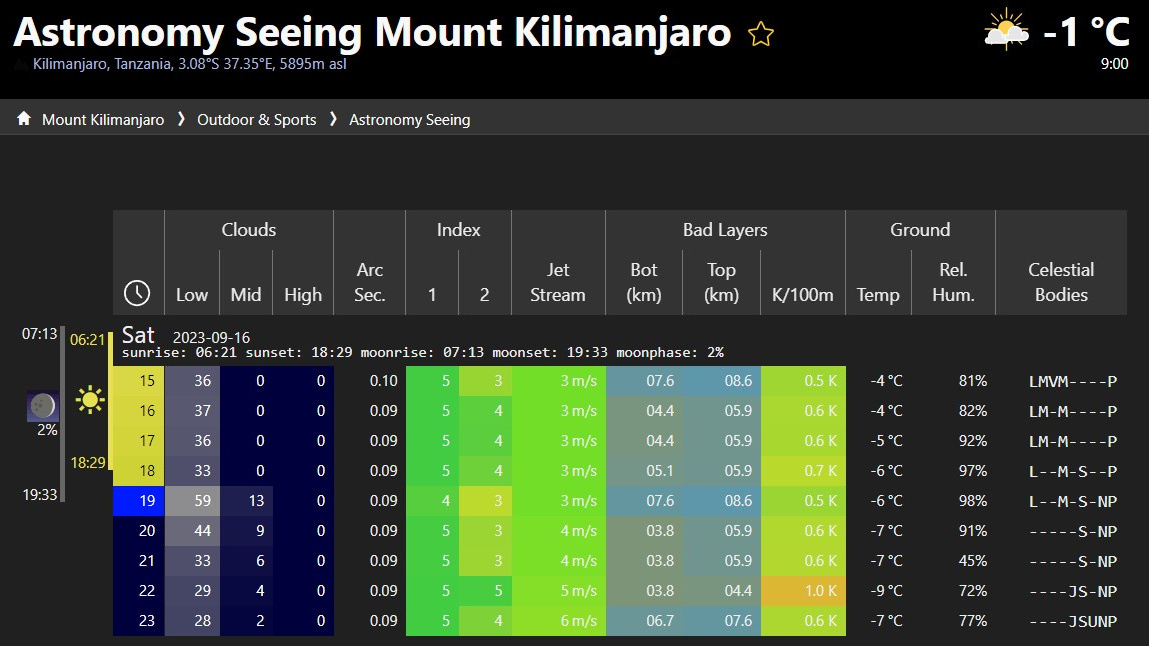Climbing Kilimanjaro will provide you with a stunning perspective of the surrounding plain, as well as the mountainside cloaked in clouds. But don’t rush down since you haven’t yet seen the big prize — the starry sky. Light pollution at Kilimanjaro’s peak is limited because it is located far from urban areas. This map depicts the level of light pollution in this area:
It is hard not to note that, as industrialization progresses, good locations for studying the sky become less and fewer each year, forcing amateurs to relocate tens or hundreds of kilometers away from cities. However, Kilimanjaro’s benefit extends beyond the absence of light pollution. Clean air and a peaceful environment are equally important:
As a consequence, as the Sun sets below the horizon and night falls, the summit of the mountain offers an amazing view of stars and celestial events. This kind appears to be incomprehensible. However, let us begin with the most basic!
Lunar Eclipse
Since childhood, most people have been aware of our planet’s satellite, the Moon. We meet her so frequently that it appears she can no longer surprise us. But one day, the full Moon will begin to plunge into shadow right before your eyes, and if you’re lucky, the Moon will become blood red after the complete immersion. But don’t worry, the shadow will soon fade and the hue will return to normal. Such moon eclipses are extremely rare, and viewing one is a huge accomplishment. Take your camera to record this cosmic spectacle!
The Moon also plays a direct role in solar eclipses, when it totally or partially obscures the Sun’s light. Partial solar eclipses are uncommon, and total solar eclipses over Kilimanjaro can occur in intervals of more than a hundred years. If you are fortunate enough to witness a solar eclipse, do not waste time photographing it; instead, observe it from start to finish. But be cautious: use sun filters, floppy disk films, or dark glasses (!)
Meanwhile, we’ll keep in touch with our nearest planetary neighbors from the summit of the mountain. The planets are visible with the naked eye from the top of the mountain throughout the most of the night, although they are difficult to distinguish from the stars. The planet Venus is an exception in that you can try to differentiate its phase when it is closest to the Earth. You can benefit from the fact that the planets follow a similar path to the Sun. Also, keep in mind that there are several mobile planetarium programs available at the time.
Installing one or two applications on your smartphone or tablet can substantially simplify your exploration of the richness of the starry sky.
Comets
Comets have also been linked to solar system objects. These tailed explorers are the most odd and intriguing visitors to the night sky. They are still one of the most attractive items to see today due to their remarkable look and uncommon beauty. And, while dazzling comets seen with the naked eye are uncommon, dimmer comets viewable with tiny binoculars are virtually constantly present in the sky.
And the following maps may assist you in locating them

Falling Stars
Furthermore, as they travel, comets leave behind a large amount of dust. When the Earth’s orbit crosses with the orbit of a comet, granules of sand burn up in our planet’s atmosphere, and we witness “falling stars.” On some days, the number of “falling stars” every hour might reach tens, hundreds, or even thousands. And the summit of Mount Kilimanjaro is ideal for witnessing this romantic and magnificent phenomena. And soon we’ll be whisked away to the huge universe of stars. You may explore the marvels of the starry sky one hour after sunset. Beautiful constellations such as Sagittarius, Eagle, Lyra, and Cygnus are preparing to set beneath the horizon, following the Sun.

Sagittarius
The legendary centaur Chiron is related with the constellation Sagittarius. Centaurs have long been regarded as harsh and vulgar creatures in Greek mythology. Chiron, on the other hand, was intelligent and well-known as a healer. According to tradition, he was the creator of the heavenly globe, which was used in the Argonauts' campaign. He left a spot for himself on this planet in the form of the constellation Sagittarius.
Sagittarius is abundant in star clusters, exceptional objects, and Milky Way star clouds. So make sure to bring binoculars! This constellation is also home to the core of our Galaxy, which draws extra attention to it. You might gaze at this constellation for hours; it’s a shame it will soon go beyond the horizon.
Eagle
The constellation Eagle is located next to the constellation Sagittarius on the Milky Way strip. According to Greek mythology, the Eagle was the bird dispatched by Zeus, the king of the gods, to take Ganymede. Altair, which means “flying eagle” in Arabic, is the brightest star in this constellation. The constellation also has some lovely star clouds.
Orpheus
A lyre-shaped constellation may be found to the east. The constellation is found in the Milky Way and contains the extremely brilliant star Vega. The constellation is called after the musical instrument of the deity Apollo’s son, the Greek singer Orpheus. Orpheus was so in love with his wife Eurydice that after her death, he travelled to Hades, the land of the dead. He used his music to put to sleep the many-headed hound Cerberus and even the god of the dead himself. The latter agreed to let him and the musician leave his underground realm in exchange for Eurydice following her husband and Orpheus not looking back.
But, haunted by uncertainty, Orpheus turned back, and his wife was lost forever in the world of shadows. In despair, the sad singer traveled the mountains and meadows, playing the lyre, until he found the priestesses of Dionysus' religion. Drunk ladies dismembered the hapless man and buried his remains in Thrace. This is the account of why local nightingales sing more beautifully than everywhere else on the planet. And the god Apollo immortalized the lyre in heaven.
Northern Cross
The constellation Cygnus, which resembles a cross, is a bit higher above the horizon. As a result, it is also known as the “Northern Cross” at times. The constellation is related with various tales. One mythology relates of Phaeton, the son of the Sun God (Helios). Phaeton was unable to manage his father’s solar chariot, causing significant damage to the Earth. Zeus murdered Phaeton with a lightning strike to avert additional flames and destruction, and his body fell into the Eridanus River. The unlucky charioteer’s best buddy spent so long searching for his body in the lake that he also transformed into a swan.
Depending on the types of birds that inhabit in the area where people live, different peoples, including Africans, have different names for this constellation. Deneb, the brightest star in the constellation, is translated from Arabic as “chicken’s tail, ” rather than “swan.”
Let’s take a break from hastily observing the setting stars and look to the opposite side. Auriga, Taurus, Orion, Canis Major, and Puppis are among the bright constellations emerging in the east.
Auriga
Auriga is a constellation composed of multiple brilliant stars that resembles a nearly regular pentagon. The narrative that gave rise to the constellation’s present name is told in the description of the constellation Cygnus and is about the son of the sun deity Helios-Phaethon. The brightest star in this constellation bears the official name Capella, however it is interpreted as “Goat” by different individuals. The three adjacent stars are known as “kids” and they represent the kids grazing next to the home, the look of which is similar of the constellation Auriga.
Taurus
Because it is placed on the Milky Way, the constellation has multiple star constellations and star clouds that may be observed with binoculars. The zodiac constellation Taurus is located next to the constellation Auriga. It is one of the oldest recognized constellations in Babylon and Egypt. Associated with a bull’s head. And the brightest star in the constellation, Aldebaran, was shown on old maps as a bull’s eye. The Hyades and Pleiades are two of the brightest and most beautiful open star clusters in the sky.
Orion
At this time, the constellation Orion, which is one of the most beautiful in the sky and comprises of very brilliant stars, is a bit closer to the horizon. A human figure may be clearly surmised from the constellation’s star arrangement. The name is derived from Poseidon’s son. Orion was a powerful and fearless hunter. He once stated that he will exterminate all creatures on Earth. However, he did not keep his pledge. The goddess of the Earth Gaia sent a venomous Scorpio to the hunter at the request of the goddess of nature and animals Artemis, who gravely injured the hunter. Orion was transported to heaven with his dog Sirius after his death.
Many nations' folk names refer to the belt of the constellation rather than the full constellation. The belt is known as “three zebras” among Africans. The nebula to the right of Orion’s belt is the jewel of this constellation. It is easily visible with the naked eye, but when viewed with binoculars, it looks like a firebird or phoenix.
Canis Major
The constellation Canis Major, which rises from the east around the same hour, was named after the hunter Orion’s dog. Sirius, the brightest star in the sky, is included in the constellation. Sirius was crucial in calendar calculations in ancient Egypt. Sirius rose in the morning, just as the Nile spilled its banks. As a result, it was thought that the sight of Sirius produced floods. Because Egypt’s well-being was dependent on the rich silt brought ashore by the Nile, Sirius played an important part in Ancient Egyptian life. Sirius rising corresponded with the onset of dry weather in ancient Rome.
It is worth mentioning that the African Dogon tribe is aware of the presence of a small Sirius satellite, which they refer to as the “deep beginning.” Some Dogon mythologists argue that the basis of this primitive tribe’s beliefs is not astronomical knowledge, but reasoning by analogy, because the Dogon link fonio with the grain and provide it with the attributes of this cereal.

Puppis
Puppis, one of the biggest constellations, is located to the right of Canis Major. According to Christian tradition, the constellation was named Noah’s Ark on star atlases. This name is related with the Flood story. Many peoples have their own flood mythology and traditions. Only two African tribes have acceptable legends. According to the Konso tribe, God was furious with the land because there was no crop. When the lone person who came to him to complain about this, God’s cup of patience spilled. Then God flooded the entire earth, and the man who had come to God was the only survivor in the constructed floating house.
The Mkulwe tribe recalls a mythology in which the rivers spilled their banks and God instructed the people to carry a pair of each animal species and plant seeds onto the ship.
After dark, the constellations Cetus, Pisces, Andromeda, Pegasus, Eridanus, Phoenix, and the Crane could be seen above the peak.
One Greek tradition connects the constellations Cetus, Andromeda, Cassiopeia, Cepheus, and Perseus (the latter three being on the northern half of the sky).
Andromeda
Cepheus was formerly the King of Ethiopia. He had a wife named Cassiopeia and a daughter named Andromeda. Cassiopeia once bragged that she was more lovely than all the sea nymphs together. As a result, the nymphs protested to Poseidon, the god of the sea. Poseidon punished Ethiopia by sending a dreadful beast, the Whale. The whale came out of the sea from time to time and ate humans. Fearful, King Cepheus dispatched emissaries to the Oracle of Zeus for assistance. The oracle revealed that in order to free the world of the plague, the monster Andromeda must be swallowed.
For a long time, the king refused to do this, but in the end, he agreed with the people. Andromeda was tied to a rock and abandoned by the monster.
Perseus
But at the time, Perseus, Zeus' son, was flying over Ethiopia in magical sandals. He was returning to Greece after fighting the Gorgon Medusa, who had deadly snakes as hair on her head. All living things turned to stone at the sight of Medusa. But Perseus defeated her with the assistance of a magical sword granted by Hermes and a shield given by Athena. Perseus admired Andromeda and resolved to save her from death. When the monster emerged from the water onto the land, Perseus rose into the air using his magical sandals. As a consequence of the combat, the hero killed Keith and saved Andromeda.
To commemorate the brave feat, all of the characters from the mythology were put in the sky and are not far apart. The Andromeda galaxy and various star clusters in the constellation Perseus are interesting things to view in this area. All items are plainly visible with the naked eye.
Pisces
The constellation Pisces is also near the constellation Cetus. The Olympian gods fled to Egypt after being terrified by the terrible Typhon, according to Greek mythology. They escaped by transforming into various animals, most notably Aphrodite into a fish. In subsequent interpretations, her kid also transformed into a fish beside her, which was mirrored in the sky as constellations. The Large and Small Magellanic Clouds may be seen with the naked eye on the southern side of the sky in the constellations Doradus and Toucan. The galaxies are named after the Portuguese explorer Ferdinand Magellan, who saw them while sailing around the world.
Meanwhile, as the clock approaches midnight, well-known northern latitude constellations like as Ursa Major, Leo, and Hydra rise in the east. Let’s take a closer look at them.

Ursa Major
Ursa Major is the most well-known constellation in northern latitudes, and it is likely that everyone there is familiar with it. It is named after the nymph Callisto and resembles a massive, magnificent ladle.
According to Greek tradition, Zeus fell in love with the lovely nymph Callisto one day. Callisto, on the other hand, was one of the nymphs that accompanied the goddess Diana at all times. Zeus then assumed the guise of Diana. When the real Diana discovered Callisto was pregnant, she yanked her away from her gaze. In rage, Zeus' wife, Hera, transformed the nymph into a bear.
Zeus then created the constellations Ursa Major and Ursa Minor to represent mother and son. Zeus tossed Callisto, holding her by the tail, which explains the Ursa’s very long tail. Even in paradise, though, Callisto could not find rest. Hera, enraged, implored the gods not to let the bear drown in the sea. The bear nymph has been circling the sky since then and does not set below the horizon in northern latitudes. One of the most ancient names for this constellation is Ursa. The Greeks, Romans, and even North American Indians all used the same name for the constellation.
Leo
Nearby is the gorgeous zodiac constellation Leo, which is named after the lion that Hercules must slay in order to complete his 12 labors. However, the constellation’s name is likely older than the Greek story. Hydra is located near the constellation Leo. The constellation is named after Hercules' victory over the horrible beast. This swamp-dwelling beast has nine heads. A human can be killed by Hydra’s breath alone. Hercules and his nephew Iolaus drew the hydra from its hiding place and began fighting it. However, overcoming Hydra was not simple.
One of her heads was eternal, while the others grew back to replace the ones that had been cut. Iolaus then proceeded to burn the necks of the severed heads, causing them to cease growing. Hercules had to secure the eternal head with a rock in order to vanquish it. The hero dipped his arrows in Hydra’s blood, and they became lethal even with a little wound.
There is now just a few hours till dawn, when we will be able to see the constellations Bootes, Coma Berenices, Virgo, Centaur, and Wolf.
Bootes
Bootes is a lovely constellation that resembles a fan. Arcturus, the brightest star, is one of the brightest in the sky. The star’s name is related with the constellation’s lore and meaning “guardian bear.” According to one account of the constellation’s name, Bootes was the first person to decide to plow the soil with the aid of an ox, making agriculture simpler for humanity. The gods rewarded him by elevating him to heaven.
A bit further up is the constellation Coma Berenices. This is an intriguing constellation made up of faint stars that are immediately noticeable. The constellation was named after the Egyptian ruler Ptolemy III’s wife. In the third century BC, the king of Egypt went to fight with the Syrian monarch and stayed for a long period. Veronica was frightened about him and prayed continually for his return.
Coma Berenices
The court priest and astnon Konon volunteered to sacrifice Veronica’s lovely long hair in order for the king to come home safely. That nightfall, Ptolemy returned victorious. The next morning, it was discovered that the hair was vanished. The couple was furious and sought an explanation from Konon. He brought Ptolemy and Veronica to the palace roof and showed them a lovely cluster of stars between the constellations Leo and Bootes, saying that the gods accepted their sacrifice and set it in the sky so that everyone may appreciate Veronica’s gorgeous hair from now on.
The constellation Virgo is located to the right of the constellations Bootes and Coma Berenices. The constellation is most commonly connected with Persephone, the daughter of the goddess Demeter, the goddess of agriculture.
Wolf
We’ll continue our voyage across the night sky by looking at the constellation Wolf. This constellation was depicted in ancient Greece as a wild beast, which the Centaur pierces with a spear and offers to the gods. The Arabs erected a lioness at this location.
Iridium flares, space satellites, and flying jets can further add to the fascination with the sky. These three events might redeem astronomy aficionados from a seemingly bleak night. When sunlight bounces off the smooth antenna of a communications satellite and reaches the viewer, an Iridium flare happens.
This phenomena appears to be similar to the smooth emergence and departure of the brightest star. The flash lasts around five seconds. And, because the positions of communication satellites are known with high precision, such flares may be predicted.
Satellites in space resemble moving star-shaped objects. They may vanish inside the Earth’s shadow and then reappear when they emerge from it. Because the satellites' positions are known with high precision, scientists can simply forecast their passing.
We’ll have to finish our voyage through the dark sky when morning arrives. We hope it will be enjoyable and thrilling. Of all, searching for treasures in the starry sky is difficult without proper planning and expertise. Be sure to bring binoculars and a camera. Binoculars are useful for viewing star fields and clouds, as well as open clusters and galaxies. Take images of everything that piques your curiosity.
The sky here is so black that you won’t be able to see everything in one night. Make the most of this nice night by arming yourself with modern instruments for exploring the night sky!


